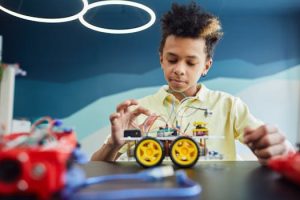Blended Learning: The Best of Both Digital and Traditional Worlds
Blended learning has been a buzzword in the education industry for a couple of years now, and for good reason. It offers the best of both digital and traditional worlds, creating a powerful and effective learning experience. The incorporation of technology in the classroom has been a game-changer, with online resources and tools enhancing the learning process. However, the traditional methods of learning still hold their value, and combining them with digital techniques has created a perfect balance in the education system. So, let’s dive in and explore how blended learning is revolutionizing the way we learn.
What is Blended Learning?
Blended learning is an approach to education that combines traditional face-to-face teaching methods with online learning activities. It takes the best elements of both digital and traditional learning and merges them together to create a seamless learning experience. Blended learning allows students to access and engage with course material through various digital platforms while still having the opportunity to interact with teachers and peers in a physical classroom setting. It is not just about adding technology to the classroom; it is about integrating it in a meaningful way to enhance learning outcomes.
The Advantages of Blended Learning
Blended learning offers many advantages that make it the best of both worlds. Firstly, it allows students to have a more personalized learning experience. Online learning resources can be tailored to cater to individual needs, and students can work at their own pace. Secondly, it provides a more flexible learning environment. With the option to access course materials online, students can study anytime and anywhere, making it easier for them to balance their studies with other commitments.
Moreover, blended learning enables students to engage and participate in different types of learning activities. The traditional classroom setting can be enhanced with digital tools such as videos, interactive quizzes, and virtual simulations, making learning more engaging and interactive. This approach also promotes critical thinking and problem-solving skills as students are exposed to a variety of learning methods.
Blended learning also benefits teachers by giving them the opportunity to use various teaching methods and resources. It allows teachers to track student progress, identify areas for improvement, and provide instant feedback, resulting in a more effective and efficient teaching experience.
Implementation of Blended Learning
The success of blended learning lies in its implementation. A well-designed blended learning program should have clear learning objectives, including a balance between traditional and digital elements. Teachers should be properly trained to effectively use technology in the classroom and provide support to students who may need help with digital tools. Communication and collaboration between teachers and students are crucial in a blended learning environment to ensure that students are meeting learning objectives and are engaged in the course material.
One of the key elements of blended learning is the Learning Management System (LMS), which serves as the central hub for course materials and communication between teachers and students. It is essential to choose an LMS that is user-friendly and provides a seamless experience for both teachers and students.
The Future of Blended Learning
The COVID-19 pandemic has accelerated the adoption of blended learning, with most schools and universities transitioning to online learning. While it was initially seen as a temporary solution, many institutions are now considering making blended learning a permanent part of their education system. This shift has paved the way for the future of blended learning, with advancements in technology making it possible to create a more immersive and engaging learning experience.
In conclusion, blended learning is a powerful and effective approach to education that combines the best of traditional and digital methods. It promotes personalized and flexible learning while providing a more engaging and interactive environment. As technology continues to evolve, the future of blended learning looks promising, and it is undoubtedly here to stay. So, embrace the best of both worlds and experience the benefits of blended learning for yourself.








